Microsoft BUILD: Windows 8, A Pre-Beta Preview
by Brian Klug & Ryan Smith on September 13, 2011 12:05 PM EST- Posted in
- BUILD
- Windows
- Microsoft
- Windows 8
- Trade Shows
Mobile Experience Side
Coming from the smartphone side of things, I really see many shades of WP7 inside Windows 8. That’s actually dramatically understating the state of things - the core of what we’ve been shown of Windows 8 that’s new literally is either adopted from or directly analogous to much of WP7.
It doesn’t come as a surprise to me at all that the desktop Windows experience is moving in this direction, (and it seems as though the Xbox 360 interface will follow shortly). The positive result is that Windows 8’s touch experience feels much closer to the ground-up approach Android Honeycomb or iOS have taken than the than the “Tablet-Edition” versions of Windows XP and the tablet integration in Vista and 7. I used a UMPC and remember Origami and how that application lived as its own standalone mode of operation as an application within windows. What Windows 8 is the inverse - Windows now lives inside a Metro-themed Start screen that looks like WP7 for the desktop. Or at least it does in this demo we’ve been shown currently.
The tablet experience is now absolutely on par with modern mobile OSes - sure there are a few more things that need to be included, but the foundation is there for Windows to suddenly become more than an OS that also can do touch-based interaction.
IE 10
Microsoft has been actively promoting IE 10 since MIX 11, with two platform previews so far, and IE 10 is an integral part of Windows 8 both as a browser and as a runtime for HTML based Metro applications. We won’t go into exacting detail about what’s new and interesting inside IE10, beyond mentioning that it improves upon IE 9’s GPU acceleration and improves web compliance support including CSS3. What’s relevant in Windows 8 is that IE 10 gets two views - one belonging to the Metro-heavy start menu experience, which we’ll call the mobile view, and the other belonging to the traditional desktop windows view.
This dichotomy exists between the two IE10 experiences, which is in itself a bit curious. The mobile view is almost exactly what IE looks like inside Windows Phone 7.5 - at the bottom is the URL bar and controls, and with a slide down gesture, at the top are tabs. Meanwhile the IE10 desktop experience uses the older IE 9 UI. At this point, it doesn’t appear that windows opened in one are transportable to the other.
The mobile view is almost exactly like WP7.5’s however, the URL bar disappears when scrolling, and the browser supports a completely fluid multitouch experience that feels speedy.
Cloud
Windows 8 offers considerable integration with Windows Live and SkyDrive. Local user accounts can be directly tied to a Live account on trusted PCs, and then be used for live roaming. Live roaming enables each connected device to access the same set of accounts for photos, email, calendar, and contacts and speed up initial setup. For example, photos captured on a WP7.5 device’s camera roll can be immediately visible on a Windows 8 PC authenticated against the same Live account. This is very close to how camera roll will integrate into Apple’s iCloud and synchronize across iOS and OS X Lion.
One thing is clear, and it’s that Microsoft plans to heavily integrate and leverage its Live services into Windows 8 and provide an ecosystem-wide way to migrate accounts settings, photos, and data between mobile, tablet, and desktop.
Samsung’s Reference Tablet
We’ve been loaned Samsung tablets running the Windows 8 Evaluation copy used for this article, and thought it bears going over since the device will no doubt become a reference platform for Windows 8 development. This hardware is also being given away to developers in attendance at BUILD as well.
The Samsung tablet is none other than the 700T model announced at IFA very recently, and it packs a relatively impressive spec list.
| Samsung 700T Windows 8 Development Notebook/Slate - Specifications | |
| Processor |
Intel Core i5-2467M (2x1.6GHz + HT, 32nm, 3MB L3, 2.3GHz Turbo, 17W) |
| Chipset | Intel 6 series |
| Memory | 4 GB DDR3 1333MHz RAM (1 SODIMM) |
| Graphics | Intel HD 3000 |
| Display | 11.6" Super PLS (1366x768) |
| Hard Drive | 64 GB Samsung SSD |
| Networking | 802.11n WiFi + Gigabit Ethernet + GSM/WCDMA HSPA+ |
| Sensors | NFC, Magenetometer, Accelerometer, GPS, ALS, Front, Rear Camera |
| Dimensions | 12.9 mm thick, 909 grams |
The 700T includes GSM/WCDMA cellular connectivity courtesy of an Option GTM661W combination cellular modem and WiFi card. The GTM661W uses a Qualcomm MDM6200 baseband, which also provides GPS. There are also sensors such as ambient light, an accelerometer, and the two cameras onboard.
In addition, the 700T includes an active digitizer and capacitive touch display, making it suited for all three interaction modes that Windows 8 will support. The device comes with a dock that doubles as a charging stand, and also replicates full size HDMI, GigE, and a USB 2.0 port on the back. The slate has one USB 2.0 port, a headphone jack, microSD card slot, SIM slot, and a rotation lock button.
Samsung calls the 700T a slate, we've elected to call it a tablet, and the device feels decent if not a bit heavy in the hands. The 700T is also the first 16:9 tablet we've seen, with Android adopting 16:10 and iOS going with 4:3, which makes portrait a bit extreme.


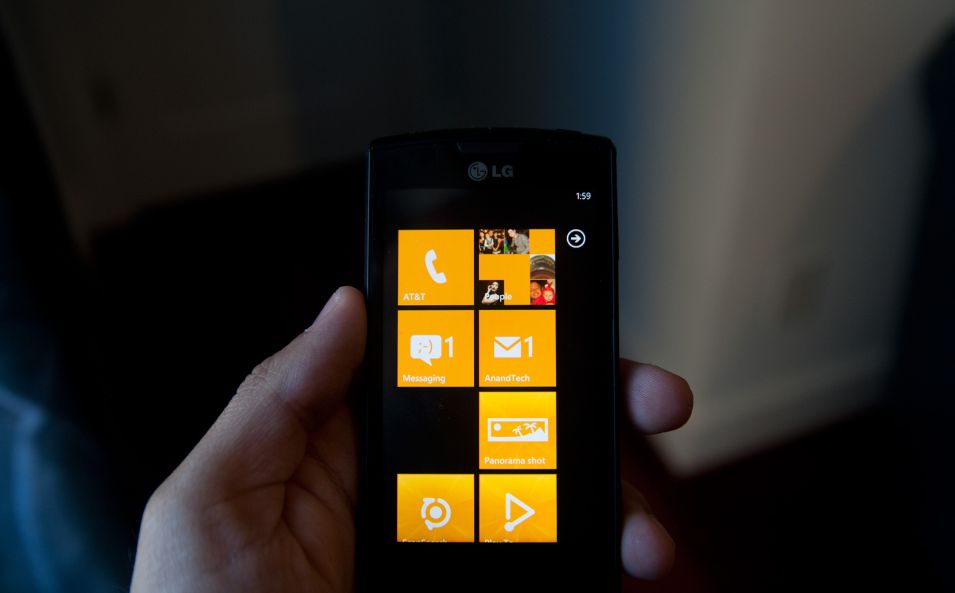
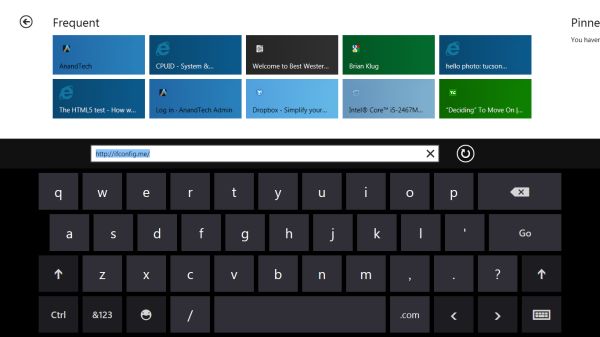
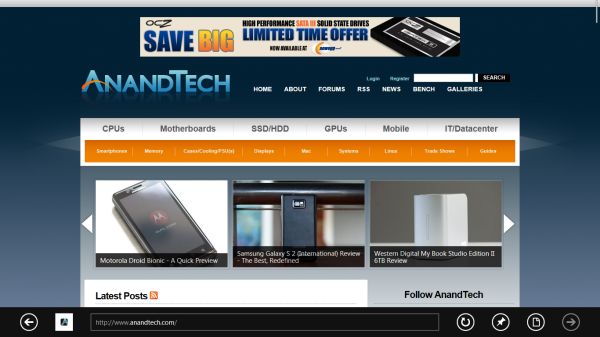
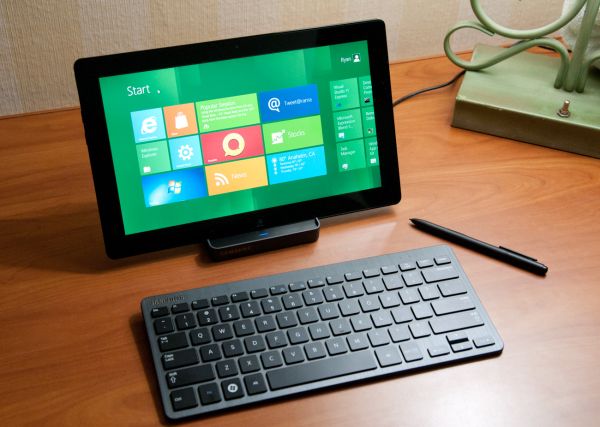
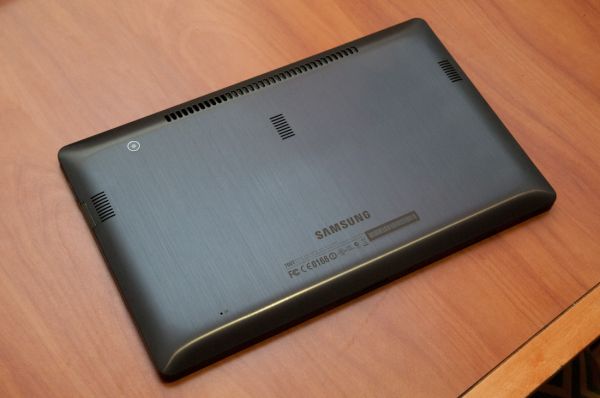
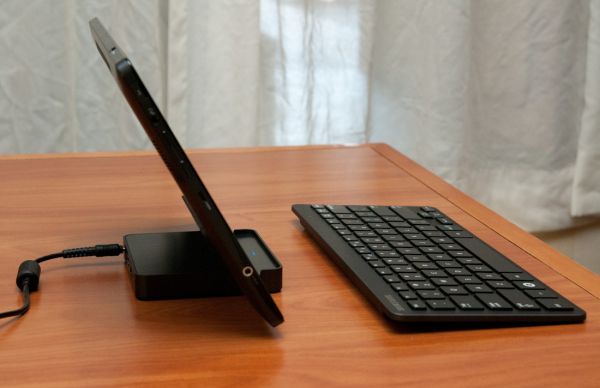








235 Comments
View All Comments
DeciusStrabo - Wednesday, September 14, 2011 - link
Yes, they function as widgets too. But compared to real widgets they are a very poor tool indeed. Limited in size, limited in what they can show. WP7 has the same problem for me: Even simple widgets in Android or Bada or Symbian blow them out of the water. The Calendar Live Tile shows only one appointment!ilkhan - Wednesday, September 14, 2011 - link
I have 11 different apps pinned to my 7 taskbar, all but one of them have at least 1 window open (several have 3, the closed one is JUST a jumplist launcher). Doing anything to hide that (as an example, requiring a fullscreen IE experience) is incredibly STUPID of microsoft. Long live Vista2.BioTurboNick - Wednesday, September 14, 2011 - link
Internet Explorer has both a Metro mode and a normal windowed mode.rdamiani - Thursday, September 22, 2011 - link
What is wrong is:- Opening a new program replaces the existing screen with a new one full of live data that will want to refresh
- Developers, sure in the certain belief that their program is the best in the world, will add tiles full of live data (that needs to be refreshed) that relate to their wonderfulness.
- The poor state of PC screen resolution - already dumbed down to a long and skinny VGA-class ribbon - won't allow you to have more than a few of these live-data tiles (needing to be refreshed) at a time.
- Everyone's computer will look different with stuff in all kinds of different places. Which will make tech support way more challenging than it already is.
Microsoft keeps learning the wrong lessons from the competition. Just because Apple ported springboard to Lion (as an application you don't need to use) doesn't mean that Microsoft needs to put springboard-on-crack front-and-center in Windows 8.
UMADBRO - Tuesday, September 13, 2011 - link
Just give it a damn chance before you hate all over it. I bet you were one of the whiners that complained about the changes that were made to Windows 7, and Vista before it, and XP before that, etc etc. FFS, If everything stayed the same, no one would have a damn reason to upgrade. And their is your other potential solution. Stick with Win 7 if you already hate 8 so much and are unwilling to give it a chance. Problem solved!futurepastnow - Wednesday, September 14, 2011 - link
I have every intention of trying out the public betas and "giving it a chance," but I'm not going to be passively fed what Microsoft thinks people want. I'm going to make it clear what I want, even if they never read these comments.And what I want is to never, ever, ever, see anything that uses Metro on a desktop computer. In the builds so far, it can't be turned off.
piiman - Wednesday, September 14, 2011 - link
"I'm going to make it clear what I want, even if they never read these comments.:Then you're just making noise. Go tell MS, don't post it somewhere they will never see it.
Wraith404 - Thursday, September 15, 2011 - link
HKEY_CURRENT_USER\Software\Microsoft\Windows\CurrentVersion\Explorerset the key RPEnabled to 0
crispbp04 - Wednesday, September 14, 2011 - link
It has nothing to do with being stupid or juvenile. It's about understanding the way a NORMAL person uses their computer.Yeah, we all get it... you think you're a big technoweenie because you require a high resolution with tiny fonts so you can cram more information per square inch than at least 10 ''normal" users. You like over-complicated menus and 100 different ways to accomplish the same task because it makes you feel special when you can whiz bang all over your operating system while someone is watching. I'm not sure why you're complaining about full screen applications anyway(in post below)... The market already decided where things should be and you're looking at it
The reality is, you're clueless. You need to change your name to just "past"... since your ideology is stuck there. You resist change, you call progression "garbage". A true power user cares more about performance and usability. We use keyboard shortcuts for nearly everything. When other people see us interact with a windows operating system, they are always blown away. (Hit start key type two letters OMG the right application/doc/email/etc opens).. "how'd you do that!?"... MUST BE MAGIC!? No.. it's called progressing with the operating system. Most people who read this don't even know their start menu can do this. (which is the ONLY sad part of windows, most users still interact with it like it's windows 95)
If you've used a windows phone 7 you know that metro is BY FAR the best setup for a desktop interface. It's proven itself in the phone form factor and will now become the defacto standard for a tablet. You can quote me on this in 2013. If you're a desktop fanatic I'm absolutely confident that microsoft will get it just right this time around. Quote me on that also.
jbaumann - Wednesday, September 14, 2011 - link
"It's proven itself in the PHONE form factor and will now become the defacto standard for a TABLET."quoted for emphasis
I cannot see how it should be a big improvement for anybody who is working at a desktop PC (i.e. no touchscreen, remember the gorilla arm), with a mouse and a keyboard.